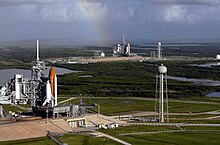STS-400
[4] It was planned that after the STS-125 mission in October 2008, Launch Complex 39B would undergo the conversion for use in Project Constellation for the Ares I-X rocket.[4] Several of the members on the NASA mission management team said at the time (2009) that single-pad operations were possible, but the decision was made to use both pads.[1][3] During the first, Grunsfeld would have depressurized on Endeavour in order to assist Gregory Johnson and Michael Massimino in transferring an EMU to Atlantis.[8] The damaged orbiter would have been commanded by the ground to deorbit and go through landing procedures over the Pacific, with the impact area being north of Hawaii.This also allowed NASA to continue processing LC-39B for the upcoming Ares I-X launch, as during the stand-down period, NASA installed a new lightning protection system, similar to those found on the Atlas V and Delta IV pads, to protect the newer, taller Ares I rocket from lightning strikes.However artwork was created for use by the mission team as an unofficial emblem by Mike Okuda, who also illustrated the official patch of STS-125.[12] As described by Paul F. Dye, Lead Flight Director of the mission, the emblem "adopts many of the elements seen in a rescue organization's patch - the square cross, bold letterers and border, and simple design.The first flight crew assigned to the mission created another, more humorous design depicting a St. Bernard with its traditional barrel of brandy replaced by the Hubble Space Telescope.



Space ShuttleEndeavourChristopher FergusonEric A. BoeRobert S. KimbroughStephen G. BowenScott D. AltmanGregory C. JohnsonMichael T. GoodMegan McArthurJohn M. GrunsfeldMichael J. MassiminoAndrew J. FeustelGeocentricLow EarthInclinationInternational Space StationHubble Space Telescopecontingency supportAtlantisSTS-125orbital inclinationusual planLaunch Complex 39BLaunch Complex 39ADiscoverySTS-119Ares I-XProject ConstellationSTS-126PositionRemote Manipulator SystemSTS-123Orbiter Processing FacilitySTS-326STS-124solid rocket boostersexternal tankExtravehicular Mobility UnitorbitersSTS-127Atlas VDelta IVMike OkudaSt. BernardSTS-3xxUniverse TodayNASASpaceflight.comSpace Shuttle EndeavourSTS-49STS-47STS-54STS-57STS-61STS-59STS-68STS-67STS-69STS-72STS-77STS-89STS-88STS-99STS-97STS-100STS-108STS-111STS-113STS-118STS-130STS-134California Science CenterLos AngelesSpace Shuttle programList of missionsList of crewsOrbiterSolid Rocket BoosterMain engineOrbital Maneuvering SystemReaction control systemThermal protection systemBooster separation motorEnterpriseColumbiaChallengerSpacelabCanadarmExtended Duration OrbiterSpacehabMulti-Purpose Logistics ModuleLaunch Complex 39Landing sitesShuttle Landing FacilityMissionscanceledMission timelineRollbacksAbort modesRendezvous pitch maneuverShuttle Mission SimulatorShuttle Training AircraftInspiration (design)Pathfinder (simulator)MPTA (engine test article)Approach and Landing TestsChallenger disasterreportColumbia disasterCrawler-transporterMate-Demate DeviceNASA recovery shipShuttle Avionics Integration Laboratory (SAIL)Shuttle Carrier AircraftflightsDeutschland-1Getaway SpecialJournalist in Space ProjectTeacher in Space ProjectShuttle-MirHitchhikerShuttle Ejection Escape SuitLaunch Entry SuitAdvanced Crew Escape SuitFreestar experimentsInflatable Antenna Experiment